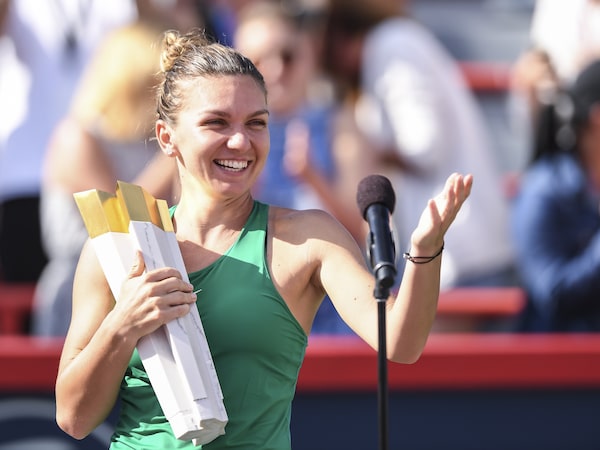
Simona Halep of Romania, holding the women's championship trophy from the 2018 Rogers Cup, won barely more than half of what the men's champion won at the same tournament.Minas Panagiotakis/Getty Images
When Rafael Nadal won the Rogers Cup in Toronto last year, he pocketed about US$1-million for his straight-sets win. At the same time, Simona Halep won the Rogers Cup in Montreal in three sets and won just more than half that.
Two tournaments – alternating between Toronto and Montreal – with the same name, and yet the men’s winner takes home almost twice that of the women’s winner.
What gives?
Despite decades of efforts by activist athletes such as Billie Jean King and modern-day stars Serena and Venus Williams, top players on the WTA Tour are still out-earned by their male counterparts on the ATP Tour.
Tennis has led the pay-equity charge in sport. The four Grand Slams offer equal prize money, along with a few other big tournaments that feature men and women. But at many others, the prize disparity is still staggering.
When players take the court at the Rogers Cup next week in Toronto and Montreal, the men will again take home substantially more prize money than the women. The Rogers Cup purse for the men is US$5.7-million this year, compared with the women’s purse of US$2.8-million.
With the U.S. women’s soccer team making news with its discrimination suit against the U.S. Soccer Federation, the conversation about pay equity in pro sports has never been louder.
King, a tennis icon and the godmother of sport’s pay-equity movement, has spoken up for those soccer players, championing female athletes every chance she gets.
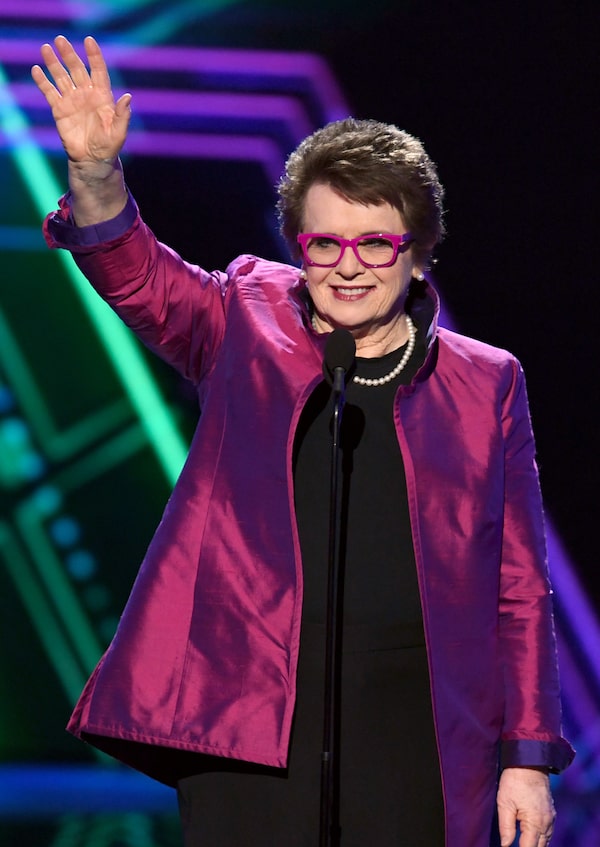
Billie Jean King at the 2019 ESPYs in July.Kevin Winter/Getty Images
“I’ll be 75 this year, and I’m still like, ‘Oh my god, this is moving at a snail’s pace,’ ” King told The Globe and Mail in a lengthy interview about the Tour she founded and the equal-prize-money battles she waged. “When you look back at history, you think it moved fast, but when you live through it? Man, it feels like it moves so slow.”
There are several reasons usually given in the tennis world for the difference in purses. The men get higher level of sponsorship, better broadcast deals and earn more revenue.
Tennis Canada – the owner and operator of the Rogers Cup – foots the bill for the Canadian tournaments’ prizes. While the two tournaments run at the same time, share a name and feature best-of-three matches, they are separate events, mandated by the two different tours that each have their own sets of guidelines for determining prize money. The Rogers Cup men’s event has a higher classification on the ATP Tour than the Rogers Cup women’s event does on the WTA Tour, and it’s those classifications that dictate the minimum prize money.
Some tournament owners have the cash flow to add to their purse. Tennis Canada says finding a way to top up the women’s purse to make it equal to the men’s is a frequent topic at board meetings. But it would mean dipping heavily into the money earmarked for tennis development.
Jennifer Bishop, chair of Tennis Canada’s board of directors, got to meet King at this year’s French Open and said, “I was more inspired than I’ve ever been in my 35 years of being involved in tennis.
“She encouraged me to keep the conversation going at the board level and to be fearless,” Bishop said. “In a perfect world, we’d be able to check all the boxes, but Rogers Cup is our revenue-generator. We have to do everything we can to help close the pay gap while at the same time making sure we have money going into our programs, like high performance and grassroots. It really is a difficult conversation, but I’m hopeful that some of the other decisions we’re making will help move the needle.”
Tennis Canada has equalized the prize money at its smaller tournaments in Vancouver and Granby, Que., with Gatineau to follow next year – all of which feature players from both the ITF Women’s Circuit and the ATP’s Challenger Tour.
Tennis Canada is also focusing on adding more female coaches into high-performance ranks and rectifying the trend of too many girls leaving the sport too soon. Building up the WTA Rogers Cup is another top initiative, particularly because increased revenue at the event leads directly to higher prize money.
“Our WTA players are compensated very well in Canada at the Rogers Cup and well taken care of, and their prize-money rate has grown at a significant rate over the years," WTA chief executive Steve Simon said. "So it shows that Tennis Canada has certainly been growing the event, and they’re very progressive.
“We obviously would love to see equal prize money at both Rogers Cups, and I think they’d love to see it, too. We all recognize that the money has to come from some place, and they have a lot of responsibilities and we respect choices federations have to make. But you’d also like to see some of the choices come to making a statement, which I think would bring a lot of value to an organization.”
“The prize money is different between the two, but the prize money as a percentage of gross revenue is about the same for both events,” Tennis Canada CEO Michael Downey said.
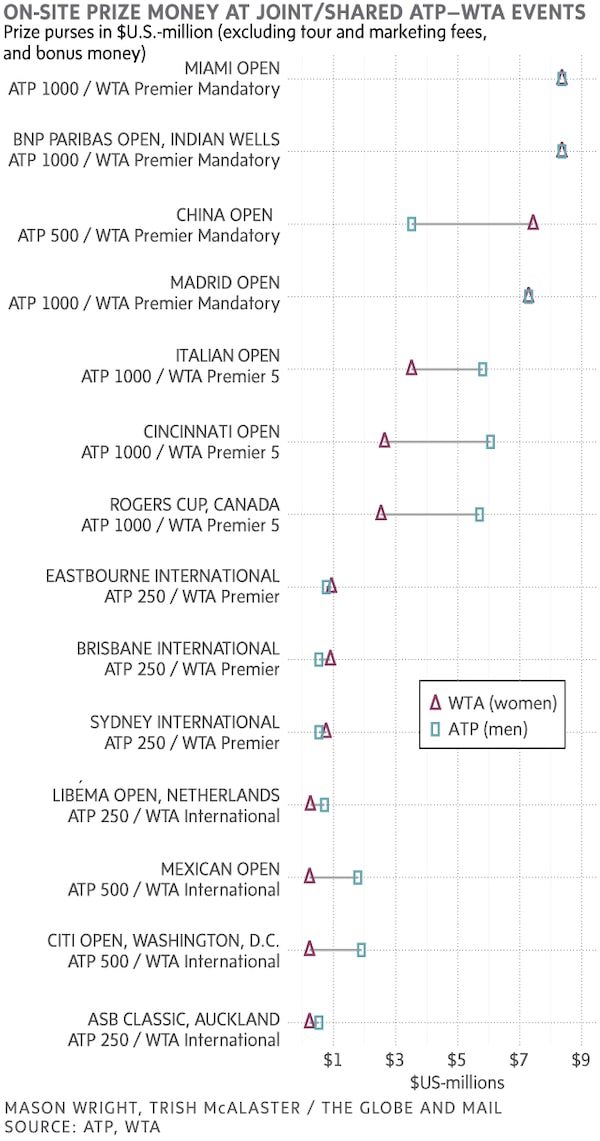
The two different event classifications at Rogers Cup have been widely cited as a big factor for the gap in prize money at the two events. The men’s is an ATP Masters 1000 event, which is mandatory and awards 1,000 rankings points to its winner. The women’s is a WTA Premier 5 event – not mandatory and worth 900 points to its champ. Points are important because they determine a player’s world ranking.
Yet the women’s Rogers Cup has had as many or more top-10 participants than the men’s every summer since 2014. Neither world No .1 Novak Djokovic nor No. 3 Roger Federer will play in Montreal this week. But all the women’s top 10 are playing in Toronto, including Serena Williams, Naomi Osaka and Wimbledon champ Halep.
A look at Tennis Canada attendance numbers for the two events shows Montreal’s tournament routinely outdraws the concurrent Toronto event each year, regardless of whether it is the WTA or ATP.
The highest ATP Rogers Cup attendance of the past 15 years in Montreal was 216,236 in 2017 (as Canadian star Denis Shapovalov made his run to the semi-finals), while its best in Toronto in that time was 161,497 in 2010. During that time, the WTA’s Montreal best was 181,996 in 2014, and its Toronto best was 138,135 in 2009.
Revenues from global broadcast and sponsorship deals also factor heavily into what the two different tours can dictate in prize money. Men’s tennis is still generating a lot more than women’s in those areas, bolstered by the popularity of megastars such as Federer, Djokovic and Nadal.
“Fundamentally, we want to help the WTA Tour,” Downey said. “How do they grow the global broadcast side of women’s tennis? And how can we build our event more? That would be a win for everyone if we were selling more tickets and more sponsorships and getting more global broadcast, because that will force the prize money to grow with the formula.”
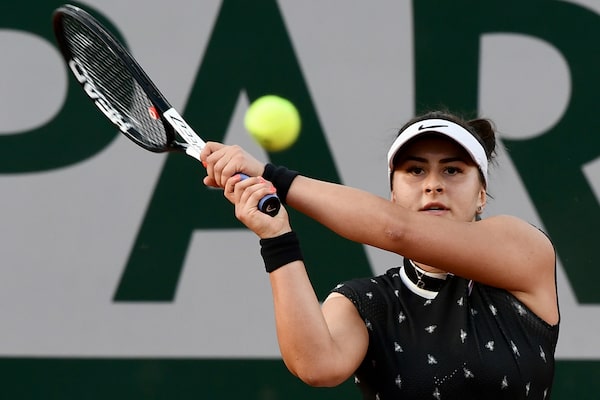
Bianca Andreescu of Mississauga, Ont., will make a highly anticipated return from injury at this year's women's Rogers Cup in Toronto.PHILIPPE LOPEZ/AFP/Getty Images
Tennis is the most financially lucrative sport for female professional athletes, in which players earn more than women in other sports by enormous margins. The WTA has 55 events around the globe yearly, with more than US$160-million in prize money.
Perhaps it’s tough to have sympathy for a tennis tour whose biggest stars routinely fill Forbes’s list of the world’s highest-earning women athletes. By way of contrast, the Canadian Women’s Hockey League, which featured Olympic gold medalists who made a maximum of $10,000 a season, shut down this spring because of a shortage of revenue.
Some corporate sponsors, eager to spotlight their progressiveness, have stepped up to help female athletes. The year-end round-robin-format WTA Finals will award the largest prize money in the history of pro tennis – men’s or women’s – with a potential pay day of US$4.725-million for an undefeated champ, thanks to Japanese beauty brand Shiseido. As discussions around pay disparity between the U.S women’s and men’s soccer teams intensified, several companies, such as Visa and energy-bar maker Luna, provided top-up funds to help close the gap.
And following the U.S. team’s run to another World Cup victory, Secret, owned by U.S. multinational Procter & Gamble, said in a huge ad in The New York Times that it would donate US$23,000 to each of the 23 players on that U.S women’s team.
It was also a deodorant sponsorship that answered King’s plea to help equalize the men’s and women’s prize money for the first time at the 1973 U.S Open – Ban deodorant, a subsidiary of pharmaceutical company Bristol-Myers. When she went to U.S Open tournament director Billy Talbert back then to request equal prize money, she had already secured Bristol-Myers’s promise that they would provide the US$50,000 needed to make up the difference. King still laughs today about a deodorant company playing rescue right after she’d famously vented to media about the pay gap by saying “it stinks.”
King says that she would like to see more players on the WTA Tour immerse themselves in the business of their tournaments – knowledge that could help in their advocacy.
“I would ideally like to see a rookie school, and they can’t play on the Tour until they understand the Tour, and the business and every aspect of an event they play in,” King said.
Is it possible that the corporate world could step up to pay the difference in prize money in events where a gap remains? The WTA’s CEO said the key is first altering the opinion of the value of women’s sports.
“If you walk into a boardroom today, it’s hard to get them to look at you and have a discussion at the same level they would be discussing a men’s property. That’s just a reality,” Simon said. “We have to change those perceptions. It’s up to us as a society. People have to be willing to look at it on an equal platform to raise the investment that comes behind it.”
Said King, “I think tennis is the leader in equality for women. People need to get behind their daughters. We have to find sponsors who have the same kind of enthusiasm they have for the men, and get behind the idea that, over time, the talent in women’s sports will get better and better.”
With reports from Jamie Ross
Here’s the situation for equal pay in other sports
Soccer
The U.S. women’s national team is in a legal dispute with the U.S. Soccer Federation over pay discrimination. The union representing the team alleges the federation unfairly pays the men’s national team more in bonuses, per-game pay, yearly pay and in daily allowances for travelling. Last week, in an open letter, U.S. Soccer president Carlos Cordeiro punched back, said his organization pays the women more than the men. On Tuesday, the union representing the men’s national team jumped into the argument and threw its support behind the women. The union said the current pay structure for women is “neither fair nor equitable.”
Golf
Golf carries a relatively high earning potential relative to other women’s pro sports, but the gap in prize money between the men’s and women’s tours remains enormous. The total men’s prize purse for the 2018-19 season is more than US$350-million for 46 events, while on the LPGA Tour, the women, who play 33 events this season, carry a total prize purse of US$66,950,000. Thai golfer Ariya Jutanugarn was the top money earner on the LPGA Tour last season, taking home US$2,743, 949. Brian Harman, who was 34th on the PGA Tour’s money list for 2018, earned about the same. This year, the U.S. Golf Association increased the winner’s share of the women’s U.S. Open to US$1-million, making it the biggest single-tournament pay day on the LPGA Tour. The first-place prize still pales in comparison to the top payout for the winner of the men’s event. Gary Woodland, the 2019 champion, took home US$2,225,000.
Basketball
The average WNBA salary has been reported to be around US$75,000, while the league minimum for an NBA player with no experience is US$838,464. There is also reportedly a large gap in the share of revenue women make when compared to NBA players. Dallas Wings point guard Skylar Diggins-Smith revealed in a 2018 blog post that WNBA players take home somewhere in the vicinity of 20 per cent of league revenues, while their counterparts in the NBA get 50 per cent.
MMA
Rhonda Rousey changed the game for women in combat sports. In her prime. Rousey was the highest-paid fighter in UFC. Even in her absence, women’s MMA has remained buoyant. That’s in large part because, unlike in most other professional sports, the UFC is giving them the platform. “It’s right,” UFC president Dana White said in a recent interview with the Wall Street Journal’s Jason Gay. Earlier this month, in a co-headlining event, there was parity in the prize money paid to the winners of the two main events. Jon Jones and Amanda Nunes both reportedly took home US$500,000.
Surfing
The World Surf League began offering equal prize money to men and women in 2018. Kelly Slater, winner of 11 world titles and arguably the face of the sport, threw his support behind the decision, saying in a league news release at the time that “female WSL athletes are equally committed to their craft as the male athletes and should be paid the same." Before closing the gap, there was as much as a US$32,000 difference between men’s and women’s winners competing at the same event.
Marathon
The World Marathon Majors, which includes races in Boston, New York, Tokyo, Chicago and Berlin, offers equal prize money to men and women’s winners, according to information on its website.
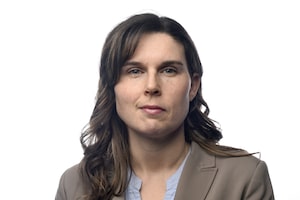 Rachel Brady
Rachel Brady